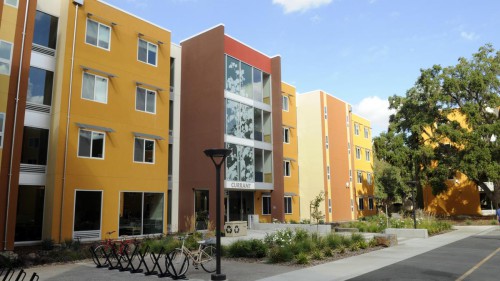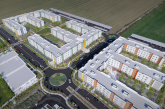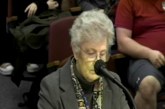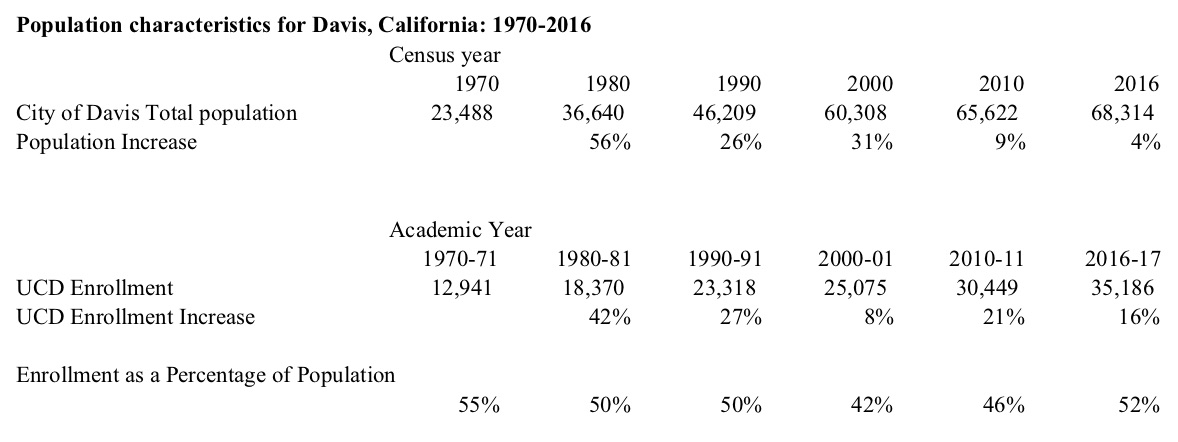
For much of the last two years plus, we have engaged in a community debate that has looked toward putting pressure on UC Davis to add more housing on campus. Part of the narrative there is that other UC Campuses have a much higher percentage of their housing on campus than UC Davis.
This comment by Eileen Samitz sums up the narrative: “The bottom line is that the City should not be enabling UCD to continue in their negligence to provide the on-campus student housing needed for its own growth. Furthermore, there is no excuse why UCD cannot provide 50% on-campus housing like UC Irvine, UC San Diego, UC Santa Barbara, UC Santa Cruz, UC Riverside, and UC Merced, particularly since UCD is the largest UC with over 5,300 acres.”
The consistent argument has been that UC Davis “with 5,300 acres, the largest campus in the UC system — historically has provided the least amount of on-campus housing.”
That is accurate as far as it goes – although the amount of land is almost irrelevant to the calculation. But the implication has been that UC Davis is negligent in failing to provide more on-campus housing.
But today we ponder the possibility that there are solid historical reasons for that arrangement – namely the availability of housing within the City of Davis and the relatively low cost of that housing, especially as compared with on-campus options.
Last week in discussions on housing on the Vanguard, some commenters made the point that Irvine was providing a higher level of housing on campus and doing it for considerably cheaper than UC 
Davis.
In part, the commenters focused on a requirement of a new housing project at UC Irvine: “Student bed rents were required to be maintained at no less than 100% of rents for comparable on-campus (UC) housing, and no more than 90% of rents for comparable off-campus (private) housing.”
It sounds good, but no one looked at the actual costs. We were able to find the estimated budget on UC Irvine campus and what we found was rather interesting. It is more expensive to live on campus than off campus, just as it is at the UC Davis campus. However, unlike on the UC Davis campus where it is 60 percent more to live on campus, the gap at UC Irvine is only $2000.
The bad news is that the gap is closed, not because the cost of living on campus is considerably less expensive, but rather the cost living on campus is considerably more expensive.
That led us to make a rather interesting discovery – a plausible explanation for why UC Davis might have a lower rate of housing on campus than comparable campuses. Simply put, while we think of Davis as an expensive place to live, it is actually cheaper, in some cases far cheaper, than the other UCs.
Davis, compared to other communities in the region, is a good deal more expensive. But it is nothing compared to some of the other locations in the UC System: La Jolla (UC San Diego), Isla Vista (UCSB), Westwood (UCLA), Santa Cruz, San Francisco, Berkeley – even Irvine is a good deal more expensive than Davis.
In fact, there are only two of the nine campuses with off-campus living in the same ballpark. UC Merced at $7987 is the only one at which it is less expensive to live off campus than UC Davis. And Riverside is close at $10,175 for the year, compared to $9792 for UC Davis.
But Davis also has the second biggest gap in costs behind UC Merced. Among UCs, Davis is second most expensive ($16,136) to live on campus. That only trails UC Berkeley at $17,549. They are followed by Santa Cruz, Merced, Riverside and UCLA.
However, the gap is not that big. Irvine, the least expensive of the UC campuses, is actually only about $1000 less to live at on campus than UC Davis, which as we said is the second most expensive. That is more than dwarfed by the massive advantage to living off campus.
What has happened at UC Merced, the system’s newest but least popular school, is that it costs about twice as much to live on campus as it does to rent an apartment nearby.
Officials told the Mercury News last June that, “as the school has grown, it’s had to add new buildings and services for students living on campus.”
“So while the off-campus market fluctuates based on the local real estate market, on-campus rates are driven more by the cost to maintain and expand the programs offered to support our students,” said Brenda Ortiz, a spokeswoman for the campus.
That may be similar to what is happening at UC Davis as well. The Vanguard has requested data on student housing fees and where that money is going.
But for our purposes here, it is important to understand that costs drive both campus decisions on housing as well as student living decisions.
What these data tell us is that historically it made a lot of sense for UC Davis to have a relatively small percentage of students living on campus. Housing off campus was available and relatively inexpensive.
That means that, traditionally, students could find housing for much cheaper off campus, where they not only paid less in base rent, but faced more flexibility in the ability to split that rent as well as food costs.
However, things started to change in the last 15 to 20 years. As we have noted, the city of Davis for years grew in tandem with the university. That means, as the university increased admission, the community added population and housing. That allowed the city by and large to keep up with and absorb enrollment increases.
But something changed shortly after 2000. The city adopted Measure R and has really not added major market rate multi-family or student housing since. The changes were masked, however, by the Great Recession which held both city population growth and UC Davis enrollment growth in check for about half a decade or so.
However, since 2012, the university has resumed its normal growth trajectory while the city has remained stagnant in terms of housing. That has put pressure on existing housing stocks.
The result has been the housing crisis in the city where rental vacancy rates have been between 0.2 and 0.4 percent the last few years.
UC Davis began its current long range development plan (LRDP) process in late 2015. There has been consistent pushback from the community as well as from elected leaders for UC Davis to address the housing crisis through additional housing on campus. UC Davis has agreed to add 8500 beds which would increase their on-campus housing from the current 29 percent up to 46 percent by 2027.
The city is also responding to the housing crisis, and a number of private development proposals have come forward, which could add another 5000 to 6000 beds.
The result is that, by 2027, we could see a much larger vacancy rate and an easing of the housing crisis. The interesting question will be whether the on-campus costs will converge toward the off-campus rental rates, or whether the nearly 60 percent gap will remain.
—David M. Greenwald reporting







“However, things started to change in the last 15 to 20 years. As we have noted, the city of Davis for years grew in tandem with the university. That means, as the university increased admission, the community added population. That allowed the city by and large to keep up with and absorb enrollment increases.”
David, please see my post last week about the changes in ratio of students to City population over the years. Starting in 1970, the growth of the City OUTPACED campus growth to at least 2000. Even after a stagnation in City growth recently, the ratio of students to City population in 2014 was still less than what it was in 1970. What is happening is that we are tending toward the balance that so many consider Davis’ “golden years.”
Think it would be useful to distinguish between “population growth”, “urban footprint growth”, and “housing stock growth”…
I suspect Richard is very ‘spot on’ as to the relative demographics related to “population growth”… may have misread his intent, but I believe that is the ‘growth’ he is primarily addressing here…
Here’s a table that provides the statistics Richard is referring to.

Useful info… thanks… doesn’t address on-campus vs. off-, but good info…
The challenge in coming up with an on-campus vs. off campus comparison is that the US Census does not consistently collect academic status information when it collects its data every 10 years. I personally believe the best “proxy” for students living off campus is the Census Cohort that counts the number of City of Davis residents aged 20 through 24. The table below compares UCD enrollment growth to the growth of that “proxy” for UCD students living off campus in the City.
Agree, with a lot of caveats, about assumptions implict in that…
In the 2000’s we had 3 in that range in our Davis household… only one was attending a State college/university, and that one was not attending UCD…
There are caveats no matter where you go. The most recent Census data had a “College/University” student field, but like in your case, the location of the college/university was not specified. Offsetting that overstatement caveat is the fact that some UCD students are over the age of 24.
David
“although the amount of land is almost irrelevant to the calculation”
Can you clarify this comment ? I do not see how this is not at least a factor.
The issue for the most part is cost of housing on versus off campus, not the availability of land. But the 5300 acres that keeps getting thrown around is not a real number, it includes a lot of land that is not developable.
David, the land is “good enough” to be developable, but the University’s mission and the Davis Community’s ag land preservation ethos run contrary to developing prime agricultural land, which the majority of the 5,300 acres is.
Yes, thank you for further clarifying.
For many reasons…
The bulk of the University’s land is used for agricultural research, with the research focused on how to feed the expanding population of the world in the future. As such, that land is a much more valuable community resource than the land surrounding Davis which is being used to grow commodity crops. The idea that we should be building on the University’s research lands in order to protect the commodity land around Davis is short-sighted and frankly ludicrous.
The total holdings are over 6000 acres. Core campus area is just over 1000 acres. West of 113 is about 3300 acres from 113 to Rd 98. Russell Ranch and Wolskill Orchards are also UC property.
The developable part of the land west of 113 is probably about 640 acres, unless you’re going to move the airport and fill in the wild area along Putah Creek.
So total land realistically available for development is 1500 – 1700 acres. Prospective area near Russell Blvd. was shot down by neighborhood opposition. The area near Nishi would require moving existing departments. Overall UCD is not that different from other UC campuses with respect to how much land they can use easily and still have the students within a reasonable distance of the core campus and basic amenities.
UCSD recognized the availability and affordability problem from the start. University City is an unincorporated area east of campus that was developed specifically because housing was not going to be available or affordable for students and staff in the nearby communities of La Jolla and Del Mar.
Good point Don. I think the key issue here is that Davis hasn’t been unaffordable to students up until this point, in fact, it remains much more affordable than campus housing.
One topic that is almost never discussed is how efficiently and effectively UCD uses its “non-agricultural” acres (the campus acres that are already urbanized). UCD has the same density issue as the City of Davis. Chancellor May’s recent statement that “We are raising our goal for new on-campus student housing in the Long Range Development Plan from 6,200 to 8,500 beds” deals with how much housing will be built on two already identified on-campus sites,Orchard Park and West Village. It is silent about increased density on any LRDP sites beyond those two. It is also silent about what UCD is doing to identify additional on-campus housing sites to add to the ones already in the LRDP.
As Council member Will Arnold has said numerous times from the dais, UCD needs to step up its game when it comes to on-campus housing … both for students and faculty, as well as staff.
Interesting that a re-developed Solano Park is not apparently “in the mix”… right across the tracks from Nishi…
Thanks to all who responded with the data. Now could one of you numeric adept also post the ratio of out of state/ out of country to in state students over the same time period broken down by decade ?
I don’t think that data is available, and again, I’m not sure why it’s that important.
It’s CRUCIAL if your bent is the leveraging of an ‘out-of-state’, ‘foreigner’, ‘full tuition’ “issue”… can think of 2-3 other posters, perhaps including Tia, who may be salivating to have that info to “use”…
So this demonstrates how successful UC Irvine’s on-campus housing programs are. UC Irvine has provided on-campus housing for 44% of its total student population, and will be providing 46% on- campus within a few years with the two additional projects in progress.
Meanwhile, UC Davis is still floundering with only 29% on-campus housing forcing 71% of its students off campus annually due to their negligence and poor planning for so many years. A big part of UCD’s problem is that it has not been building nearly enough apartments on campus for freshmen to transition into from the dorms. Davis is housing 68% of UCD’s student population which is inexcusable because UCD has over 5,300 acres to provide the needed on-campus student housing.
There is no reason why UCD can’t accomplish what UC Irvine has, particularly since UCD has so much land. UCD needs to build at least 10,000 beds on-campus to address their new growth as well as to address their backlog of needed on-campus student housing.
But part of the problem is you are not looking at the economic driver here. Off campus housing in Irvine is 80 percent more expensive than it is at Davis.
If Eileen were to learn more about UC Irvine she would find out that UC bought the land from Billionaire Irvine Company developer Don Bren for $1. Since the school started it has had strong support from both Bren and the Irvine Company who helped the university grow and become more respected to increase the value of the developers land surrounding the school. As David mentioned off campus housing is a lot more expensive in Irvine and Zilow shows multiple homes over listed for sale over $5 million (and one listed for over $10 million) within a couple miles of the UCI campus.